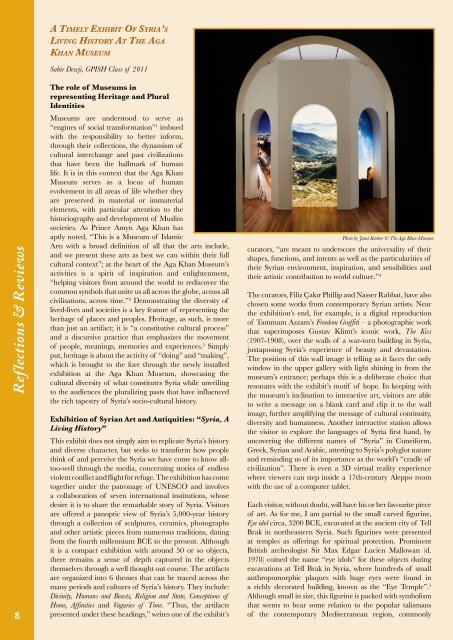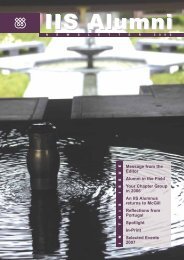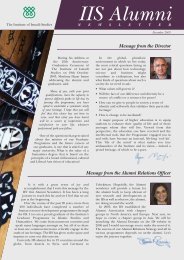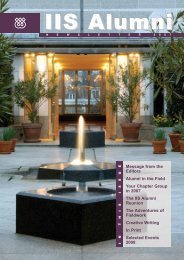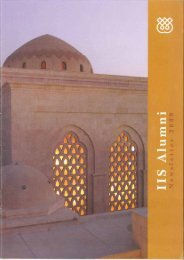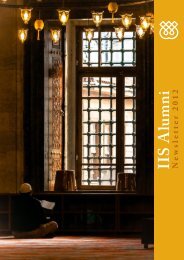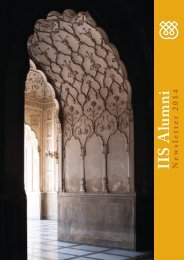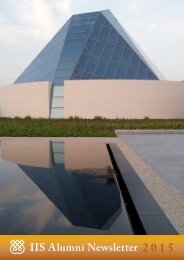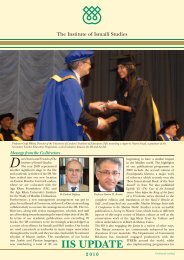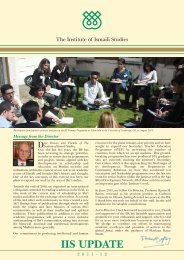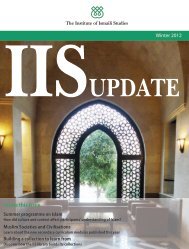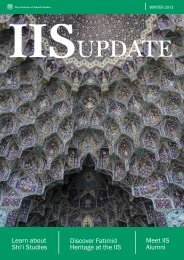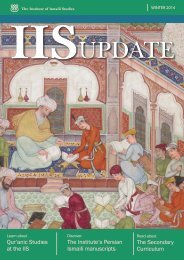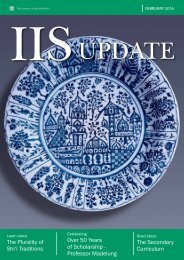IIS Alumni Booklet 2016
You also want an ePaper? Increase the reach of your titles
YUMPU automatically turns print PDFs into web optimized ePapers that Google loves.
Reflections & Reviews<br />
8<br />
A Timely Exhibit Of Syria’s<br />
Living History At The Aga<br />
Khan Museum<br />
Sahir Dewji, GPISH Class of 2011<br />
The role of Museums in<br />
representing Heritage and Plural<br />
Identities<br />
Museums are understood to serve as<br />
“engines of social transformation” 1 imbued<br />
with the responsibility to better inform,<br />
through their collections, the dynamism of<br />
cultural interchange and past civilizations<br />
that have been the hallmark of human<br />
life. It is in this context that the Aga Khan<br />
Museum serves as a locus of human<br />
evolvement in all areas of life whether they<br />
are preserved in material or immaterial<br />
elements, with particular attention to the<br />
historiography and development of Muslim<br />
societies. As Prince Amyn Aga Khan has<br />
aptly noted, “This is a Museum of Islamic<br />
Arts with a broad definition of all that the arts include,<br />
and we present these arts as best we can within their full<br />
cultural context”; at the heart of the Aga Khan Museum’s<br />
activities is a spirit of inspiration and enlightenment,<br />
“helping visitors from around the world to rediscover the<br />
common symbols that unite us all across the globe, across all<br />
civilisations, across time.” 2 Demonstrating the diversity of<br />
lived-lives and societies is a key feature of representing the<br />
heritage of places and peoples. Heritage, as such, is more<br />
than just an artifact; it is “a constitutive cultural process”<br />
and a discursive practice that emphasizes the movement<br />
of people, meanings, memories and experiences. 3 Simply<br />
put, heritage is about the activity of “doing” and “making”,<br />
which is brought to the fore through the newly installed<br />
exhibition at the Aga Khan Museum, showcasing the<br />
cultural diversity of what constitutes Syria while unveiling<br />
to the audiences the pluralizing pasts that have influenced<br />
the rich tapestry of Syria’s socio-cultural history.<br />
Exhibition of Syrian Art and Antiquities: “Syria, A<br />
Living History”<br />
This exhibit does not simply aim to replicate Syria’s history<br />
and diverse character, but seeks to transform how people<br />
think of and perceive the Syria we have come to know alltoo-well<br />
through the media, concerning stories of endless<br />
violent conflict and flight for refuge. The exhibition has come<br />
together under the patronage of UNESCO and involves<br />
a collaboration of seven international institutions, whose<br />
desire it is to share the remarkable story of Syria. Visitors<br />
are offered a panoptic view of Syria’s 5,000-year history<br />
through a collection of sculptures, ceramics, photographs<br />
and other artistic pieces from numerous traditions, dating<br />
from the fourth millennium BCE to the present. Although<br />
it is a compact exhibition with around 50 or so objects,<br />
there remains a sense of depth captured in the objects<br />
themselves through a well thought out course. The artifacts<br />
are organized into 6 themes that can be traced across the<br />
many periods and cultures of Syria’s history. They include:<br />
Divinity, Humans and Beasts, Religion and State, Conceptions of<br />
Home, Affinities and Vagaries of Time. “Thus, the artifacts<br />
presented under these headings,” writes one of the exhibit’s<br />
Photo by Janet Kimber © The Aga Khan Museum<br />
curators, “are meant to underscore the universality of their<br />
shapes, functions, and intents as well as the particularities of<br />
their Syrian environment, inspiration, and sensibilities and<br />
their artistic contribution to world culture.” 4<br />
The curators, Filiz Çakır Phillip and Nasser Rabbat, have also<br />
chosen some works from contemporary Syrian artists. Near<br />
the exhibition’s end, for example, is a digital reproduction<br />
of Tammam Azzam’s Freedom Graffiti – a photographic work<br />
that superimposes Gustav Klimt’s iconic work, The Kiss<br />
(1907-1908), over the walls of a war-torn building in Syria,<br />
juxtaposing Syria’s experience of beauty and devastation.<br />
The position of this wall image is telling as it faces the only<br />
window in the upper gallery with light shining in from the<br />
museum’s entrance; perhaps this is a deliberate choice that<br />
resonates with the exhibit’s motif of hope. In keeping with<br />
the museum’s inclination to interactive art, visitors are able<br />
to write a message on a blank card and clip it to the wall<br />
image, further amplifying the message of cultural continuity,<br />
diversity and humanness. Another interactive station allows<br />
the visitor to explore the languages of Syria first hand, by<br />
uncovering the different names of “Syria” in Cuneiform,<br />
Greek, Syrian and Arabic, attesting to Syria’s polyglot nature<br />
and reminding us of its importance as the world’s “cradle of<br />
civilization”. There is even a 3D virtual reality experience<br />
where viewers can step inside a 17th-century Aleppo room<br />
with the use of a computer tablet.<br />
Each visitor, without doubt, will have his or her favourite piece<br />
of art. As for me, I am partial to the small carved figurine,<br />
Eye idol circa, 3200 BCE, excavated at the ancient city of Tell<br />
Brak in northeastern Syria. Such figurines were presented<br />
at temples as offerings for spiritual protection. Prominent<br />
British archeologist Sir Max Edgar Lucien Mallowan (d.<br />
1978) coined the name “eye idols” for these objects during<br />
excavations at Tell Brak in Syria, where hundreds of small<br />
anthropomorphic plaques with huge eyes were found in<br />
a richly decorated building, known as the “Eye Temple”. 5<br />
Although small in size, this figurine is packed with symbolism<br />
that seems to bear some relation to the popular talismans<br />
of the contemporary Mediterranean region, commonly


